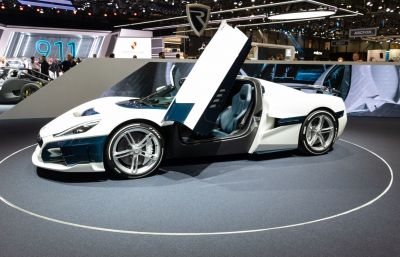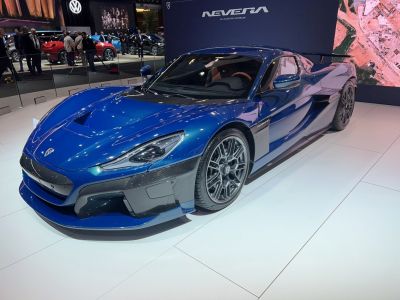 2017 Pagani Huayra BC Dimensions, Size & Specs
2017 Pagani Huayra BC Dimensions, Size & SpecsMeasurements of the 2017 Pagani Huayra BC, engineered for optimal performance and comfort
| Dimensions | |
|---|---|
| Length: | 4724 mm186.0 in15.5 ft |
| Width: | 1934 mm76.1 in6.3 ft |
| Width (Opened Mirrors): | 2040 mm80.3 in6.7 ft |
| Height: | 1174 mm46.2 in3.9 ft |
| Weight Specifications | |
| Curb Weight: | 1218 kg2685 lbs |
The Pagani Huayra BC is a highly exclusive and extreme iteration of the Italian supercar series, produced from 2016 to 2019 with the 2017 model year being a prominent example. As a coupe, the Huayra BC stands out with aggressive styling and cutting-edge engineering. The car measures 4724 mm (186.0 inches) in length, making it a compact yet aerodynamic sports coupe optimized for high-speed stability and performance. Its width is 1934 mm (76.1 inches) without mirrors, expanding to 2040 mm (80.3 inches) when the side mirrors are opened, contributing to enhanced driver visibility while maintaining a wide stance. Standing just 1174 mm (46.2 inches) tall, the Huayra BC highlights a low center of gravity essential for superb handling dynamics. In terms of weight, the vehicle tips the scales at a lightweight 1218 kg (2685 lbs), a testament to extensive use of carbon fiber and lightweight materials, which aid in delivering explosive acceleration and agile maneuverability. Overall, the Pagani Huayra BC combines compact supercar dimensions with lightweight precision engineering, making it a benchmark in size and performance comparisons within the elite hypercar segment.
Discover the standout features that make the 2017 Pagani Huayra BC a leader in its class
Have a question? Please check our knowledgebase first.
The Pagani Huayra BC, produced between 2016 and 2019, has an overall length of 4724 mm (186.0 inches), a width of 1934 mm (76.1 inches), which extends to 2040 mm (80.3 inches) with mirrors opened, and a height of 1174 mm (46.2 inches). It has a curb weight of 1218 kg (2685 lbs). These dimensions reflect the car's low-slung, aggressive stance designed for optimal aerodynamic performance and handling.
A standard residential garage typically measures about 2400 to 2700 mm (94.5 to 106.3 inches) in width and around 4800 to 5400 mm (189 to 212.6 inches) in length. The Pagani Huayra BC's length of 4724 mm (186.0 inches) comfortably fits within the length range for most garages. However, the width with mirrors opened at 2040 mm (80.3 inches) can be a tight fit in European-style garages or smaller spaces. With mirrors folded or closed, the width of 1934 mm (76.1 inches) is easier to accommodate. Its low height of 1174 mm (46.2 inches) poses no clearance issues in standard garages. Overall, the Huayra BC should fit into a standard garage, but careful maneuvering may be needed due to width with mirrors.
The Pagani Huayra BC has a track width of 1934 mm (76.1 inches) when the side mirrors are closed or folded. When the mirrors are opened, the width increases to 2040 mm (80.3 inches). This extra 106 mm (4.2 inches) in width due to the mirror position accounts for improved rear visibility but requires additional space when parking or maneuvering in tight spaces.
With a height of just 1174 mm (46.2 inches), the Pagani Huayra BC is notably low to the ground, which plays a crucial role in its aerodynamic efficiency and center of gravity. This low stance reduces drag and enhances downforce, enabling superior high-speed stability and cornering performance. From a practicality standpoint, the low height means the car has a lower seating position, which may affect ingress and egress for passengers and limits headroom, but this is typical in hypercars designed primarily for performance.
The Huayra BC weighs in at approximately 1218 kg (2685 lbs) curb weight, which is impressively light for a car of its power and capability. This light weight is largely due to the extensive use of carbon-titanium composite materials throughout the body and chassis. A reduced curb weight contributes to quicker acceleration, more agile handling, and improved braking performance, which are critical factors in the Huayra BC's high-performance design.
The Huayra BC is a more extreme, track-focused iteration of the original Huayra. In terms of size, both models share very similar dimensions, with the BC being just marginally lighter and aerodynamically optimized. The original Huayra measures approximately 4724 mm in length and around 1930 mm in width, comparable to the BC’s 4724 mm length and 1934 mm width. The BC improves on weight savings and aerodynamic features, pushing the envelope beyond the original while maintaining the foundational size and footprint.
Compared to comparable hypercars from the same era, the Huayra BC's dimensions fall within a similar range. For example, the Ferrari LaFerrari measures roughly 4702 mm (185.1 inches) in length and 1973 mm (77.7 inches) in width, making it slightly shorter but wider. The McLaren P1 is approximately 4587 mm (180.6 inches) long and 1946 mm (76.6 inches) wide, a bit more compact in length but close in width. The Huayra BC’s length, width, and especially its curb weight of 1218 kg (2685 lbs) make it competitive in size and notably lighter than many peers, emphasizing performance and handling.
The Pagani Huayra BC, like most high-performance hypercars, is designed primarily for speed and driving dynamics rather than passenger comfort or spaciousness. It features a two-seat coupe layout with limited interior space but crafted with luxurious materials and bespoke detailing. Its compact dimensions and low height mean that the cabin is snug, emphasizing driver engagement. Headroom and legroom are sufficient for most adult drivers, though accessibility can be more challenging due to the car’s low profile and sports seats.
Yes, the Huayra BC's dimensions and design integrate extreme aerodynamic enhancements to maximize track performance. The car’s relatively compact length of 4724 mm and low height of 1174 mm enable a low drag coefficient, while the width, including extended aero elements and mirrors, ensures stability. The widened stance improves cornering grip. Additionally, the extensive use of lightweight carbon-titanium reduces weight, contributing to its aggressive handling characteristics. These factors collectively create a car that is both dimensionally optimized and aerodynamically advanced for superior track performance.
Given its hypercar nature, the Huayra BC’s compact dimensions are more focused on performance than fuel efficiency. The low height and aerodynamic shape help reduce drag, which can marginally improve fuel efficiency at high speeds relative to less aerodynamically optimized cars. However, the large twin-turbocharged V12 and lightweight construction mean fuel consumption will be high in real-world use, especially during spirited driving. The compact size also aids in maneuverability in tight spaces, but practicality is limited by low ground clearance and a small storage area typical of hypercars.
Discover similar sized cars.

| Production: | 2019-present |
|---|---|
| Model Year: | 2019 |
| Length: | 4750 mm187.0 in |
| Width: | 1986 mm78.2 in |
| Height: | 1208 mm47.6 in |

| Production: | 2021-present |
|---|---|
| Model Year: | 2021 |
| Length: | 4750 mm187.0 in |
| Width: | 1986 mm78.2 in |
| Height: | 1208 mm47.6 in |
